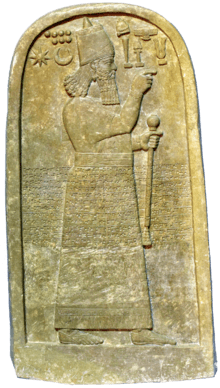Asharid-apal-Ekur
Ašarēd-apil-Ekur, inscribed ma-šá-rid-A-É.KUR[i 1] or mSAG.KAL-DUMU.UŠ-É.KUR[i 2] and variants,[i 3] meaning “the heir of the Ekur is foremost,” was the son and successor of Tukultī-apil-Ešarra I as king of Assyria, reigning for just two years, 1076/5–1074 BC, during the turmoil that engulfed the end of that lengthy reign, and he was the 88th king to appear on the Assyrian King List. His reign marked the elevation of the office of ummânu, “royal scribe,” and he was the first to have this recorded next to the king’s name on the Synchronistic King List,[i 4] possibly identifying the contemporary redactor of this list.[1]
| Asharid-apal-Ekur | |
|---|---|
| King of Assyria | |
| King of the Middle Assyrian Empire | |
| Reign | 1076–1074 BC |
| Predecessor | Tiglath-Pileser I |
| Successor | Ashur-bel-kala |
| Father | Tiglath-Pileser I |
Biography
According to an early reading of the Synchronistic King List,[i 4] he was a contemporary of the Babylonian king Itti-Marduk-balāṭu, c. 1140–1132 BC, where this monarch had perhaps been relocated to follow Marduk-nādin-aḫḫē, c. 1099-1082 BC.[2] This part of the cuneiform text is now lost[3]:448 or disproven.[3]:267 Current theories of chronological succession suggest Marduk-šāpik-zēri, c. 1082–1069 BC, may have been his Babylonian counterpart, with Rowton suggesting synchronizing the two-year reign of Ašarēd-apil-Ekur with this king's 5th and 6th years.[4]
There are no royal inscriptions known from his reign and he appears only in later king lists and in an eponym list.[i 5][5] He was succeeded by his brother Aššur-bel-kala, then his nephew Eriba-Adad II, then his other brother Šamši-Adad IV.
Inscriptions
- Khorsabad Kinglist: iii 41.
- SDAS Kinglist iii 27.
- Nassouhi Kinglist iv 8: [mS]AG-A-É.KUR.
- Synchronistic King List, KAV 216 (ass. 14616c), ii 18.
- KAV 21 iii 13, as [... ]-A-É.KUR.
References
- A. K. Grayson (1980–83). "Königslisten und Chroniken. B. Akkadisch". In D.O. Edzard (ed.). Reallexikon Der Assyriologie Und Vorderasiatischen Archäologie. 6. Walter De Gruyter. pp. 117–119.
- I. J. Gelb (1954). "Two Assyrian King Lists". Journal of Near Eastern Studies. VIII (4): 273.
- D. J. Wiseman (1975). "XXXI: Assyria and Babylonia, c. 1200-1000 BC". In I. E. S. Edwards (ed.). Cambridge Ancient History, Volume 2, Part 2, History of the Middle East and the Aegean Region, c. 1380-1000 BC. Cambridge University Press. pp. 448, 467.
- W. C. Hayes; M. B. Rowton; F. H. Stubbings (1962). Chronology: Egypt; Wester Asia; Aegean Bronze Age. Cambridge University Press. p. 34.
- J. A. Brinkman (1998). K. Radner (ed.). The Prosopography of the Neo-Assyrian Empire, Volume 1, Part I: A. The Neo-Assyrian Text Corpus Project. pp. 139–140.
| Preceded by Tiglath-Pileser I |
King of Assyria 1076–1074 BC |
Succeeded by Ashur-bel-kala |
